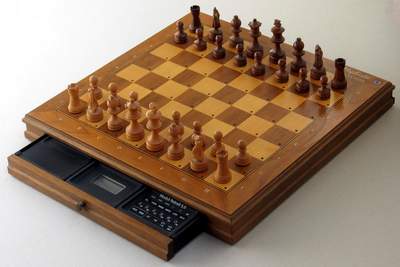Paw In The Bottle (15 October 2008)
According to writer James Hadley Chase, monkeys in Brazil are caught in the following way:
They put a nut in a bottle and tie the bottle to a tree. The monkey grasps at the nut, but the neck of the bottle is too narrow for the monkey to withdraw its paw along with the nut. You’d think that the monkey would let go of the nut and escape? But alas! The monkey is so greedy that it never does!
As self-appointed curator of the Overtom Chess Computer Museum, I play hundreds of games with chess computers, if only to heed Arno Kreuzberg's advice that chess computers should be used at least once a year.
Yesterday I witnessed a game between Fritz-5-ply and Mephisto Rebell, which reminded me of James Hadley Chase's story.
 Mephisto Rebell
Mephisto Rebell
On the 55th move, the following situation came about:
It is clear that white has a won game. But there is one little problem: black can delay checkmate as long as he can give checks; white may not capture the rook because then black has no moves left and is stalemated. Black realizes this and keeps giving checks.
After a series of fifteen checks, black gave check again with 70...Rd1-e1+ .
70...Rd1-e1+
The last fifteen moves would have taught a human player that he had to find a way to put an end to the stalemate threat. At this point white had the chance to stave off this threat with 71. Nf6-e4.
But Fritz turned out to be the monkey with the paw in the bottle. He held on to his knight, which seemed to be positioned so favourably but in reality contributed considerably to his plight, and played 71. Ke5-d5.
To make a long story short, on the 81st move, the game was drawn, as can be seen in the game below:
White: Fritz 8 (5 ply)
Black: Mephisto Rebell 5 (± 60 seconds / move)
A few other games played by these two computers can be seen on this page.
On the same page you can see that Rebel also played a much stronger game against Fritz-5-ply, which game was also drawn (probably an unnecessary draw as well).